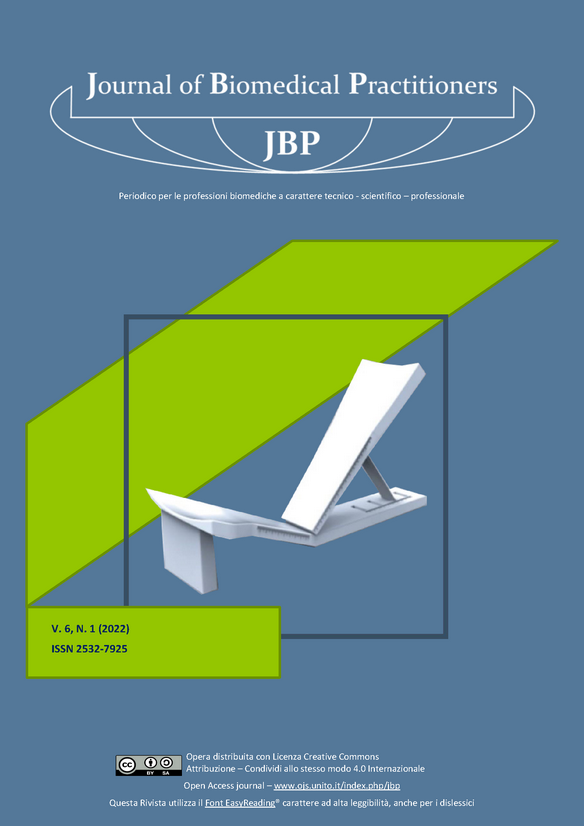“Nurse Assistant (NA)! Let’s do it?” A cross sectional study to investigate the complementary competencies and care workload perceived by NAs.
Main Article Content
Abstract
INTRODUCTION
A decree is at the center of the Italian debate. It allows Nurse Assistants (NAs) with complementary training, to perform certain "border" actions generally considered of nursing competence. The decree would partially solve the problem related to the shortage of nurses, which reached its maximum expression with the COVID-19 pandemic.
AIM
The study aims to analyze the care workload perceived by NAs in the Covid-19 era and the approval rates of the complementary procedures.
MATERIALS AND METHODS
A cross-sectional observational study was conducted through the administration of an online questionnaire. 136 responses were received.
RESULTS
Results show that NAs perceive an increased demand for care regarding the following needs: hygiene, movement, and elimination. The complementary skills most appreciated are detection and annotation of parameters, blood glucose detection, and the execution of simple dressings and bandages.
CONCLUSIONS
Hospital organizational dynamics could benefit from the NAs carrying out "border" activities. In fact, NAs would be more incentivized to participate in departmental activities if they acquired more skills and put in charge of their work responsibilities.
Downloads
Article Details
The authors agree to transfer the right of their publication to the Journal, simultaneously licensed under a Creative Commons License - Attribution that allows others to share the work indicating intellectual authorship and the first publication in this magazine.
References
[2] Garland TN, Schirm V. Nurses’ perceptions of the nurse assistant role in providing quality care in the nursing home. Gerontology and Geriatrics Education 1998;18:71–83. https://doi.org/10.1300/J021v18n04_06.
[3] Abrahamson K, Fox R, Roundtree A, Farris K. Nursing assistants’ perceptions of their role in the resident experi-ence. Nursing & Health Sciences 2020;22:72–81.
[4] Kostiwa IM, Meeks S. The relation between psychological empowerment, service quality, and job satisfaction among certified nursing assistants. Clinical Gerontologist 2009;32:276–92.
[5] Blay N, Roche MA. A systematic review of activities undertaken by the unregulated Nursing Assistant. Journal of Advanced Nursing 2020;76:1538–51. https://doi.org/10.1111/jan.14354.
[6] ECOSS CG, Opportuni GP, Pesavento L, Postal M, Taccon M, Milan P, et al. Le attività degli Operatori Socio-Sanitari nei contesti ospedalieri: uno studio mixed-method. ASSIST INFERM RIC 2019;38:6–14.
[7] Weitzel T, Robinson SB. A model of nurse assistant care to promote functional status in hospitalized elders. Jour-nal for Nurses in Professional Development 2004;20:181–6.
[8] Bollettino Unico Regionale n.45 02-04-2021. Approvazione del percorso di “Formazione complementare in assi-stenza sanitaria dell’Operatore Socio-Sanitario” e modalità organizzative di carattere generale. 2021.
[9] Gazzetta Ufficiale n.51 3-3-2003. Accordo tra il Ministro della salute, il Ministro del lavoro e delle politiche so-ciali, le Regioni e le Province autonome di Trento e di Bolzano per la disciplina della formazione complementare in assistenza sanitaria. 2003.
[10] Saiki M, Kunie K, Takemura Y, Takehara K, Ichikawa N. Relationship between nurses’ perceptions of nursing assis-tant roles and information-sharing behaviors: A cross-sectional study. Nursing and Health Sciences 2020;22:706–13. https://doi.org/10.1111/nhs.12717.
[11] Saiki M, Takemura Y, Kunie K. Nursing assistants’ desired roles, perceptions of nurses’ expectations and effect on team participation: A cross-sectional study. Journal of Nursing Management 2021;29:1046–53. https://doi.org/10.1111/jonm.13242.
[12] Pedersen ER, Kurz J. Using Facebook for health-related research study recruitment and program delivery. Cur-rent Opinion in Psychology 2016;9:38–43.
[13] Stokes Y, Vandyk A, Squires J, Jacob JD, Gifford W. Using Facebook and LinkedIn to Recruit Nurses for an Online Survey. Western Journal of Nursing Research 2019;41:96–110. https://doi.org/10.1177/0193945917740706.
[14] DataReportal. Global Social Media Stats 2021. https://datareportal.com/social-media-users (accessed December 29, 2021).
[15] Kosinski M, Matz SC, Gosling SD, Popov V, Stillwell D. Facebook as a research tool for the social sciences: Oppor-tunities, challenges, ethical considerations, and practical guidelines. American Psychologist 2015;70:543.
[16] Schneider D, Harknett K. What’s to like? Facebook as a tool for survey data collection. Sociological Methods & Research 2019.
[17] Houser J. Nursing research : reading, using, and creating evidence. Sudbury, MA: Jones & Bartlett Learning; 2016.
[18] Cavaliere B, Snaidero D. Metodologia per la rilevazione della complessità assistenziale infermieristica: calcolo dell’indice di complessità assistenziale. Management Infermieristico 1999;1:32–6.
[19] Cavaliere B, Piu F, Di Matteo R. La metodologia di determinazione degli Indici di Complessita’Assistenziale (ICA): studio osservazionale prospettico in una Stroke Unit. Professioni Infermieristiche 2012;65.
[20] Primavera E, Leonelli S. Un’indagine sulla percezione del carico assistenziale tra gli infermieri italiani, nell’era del COVID-19. Nsc Nursing 2020;4:57–83. https://doi.org/10.32549/opi-nsc-43.
[21] Gazzetta Ufficiale n.91 19-04-2001. Accordo tra il Ministro della sanità, il Ministro per la solidarietà sociale e le Regioni e Province autonome di Trento e Bolzano, per la individuazione della figura e del relativo profilo pro-fessionale dell’operatore socio-sanitario. 2001.
[22] ISTAT. Noi Italia. 100 statistiche per capire il paese in cui viviamo. Roma: 2013.
[23] Kalisch BJ. Nurse and nurse assistant perceptions of missed nursing care: What does it tell us about teamwork? Journal of Nursing Administration 2009;39:485–93. https://doi.org/10.1097/NNA.0b013e3181bd61ac.
[24] Scheepers RA, Smeulders IM, van den Broek T. The impact of an additional nurse assistant during evening shifts on nurses’ perceptions of job demands, job resources and well-being. Journal of Advanced Nursing 2021;77:1013–6. https://doi.org/10.1111/jan.14698.
[25] Lopez-Picazo JJ, Vidal-Abarca I, Beteta D, López-Ibáñez M, García-Vázquez E. Impact of the COVID-19 Pan-demic on the Hospital: Inpatient’s Perceived Quality in Spain. Journal of Patient Experience 2021;8. https://doi.org/10.1177/2374373521998625.
[26] Bondavalli P, Guberti M, Iemmi M. La collaborazione tra infermiere e operatore socio sanitario: indagine conosci-tiva sui comportamenti in ambito ospedaliero. Professioni Infermieristiche 2012;65:225–34.
[27] Abrahamson K, Fox R, Roundtree A, Farris K. Nursing assistants’ perceptions of their role in the resident experi-ence. Nursing and Health Sciences 2020;22:72–81. https://doi.org/10.1111/nhs.12649.
[28] Tribunale Amministrativo Regionale Veneto. Ordinanza N. 00301/2021. 2021.

